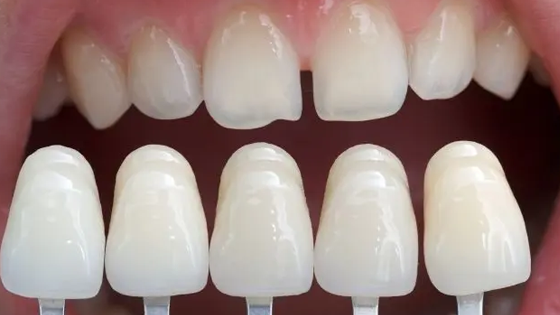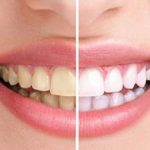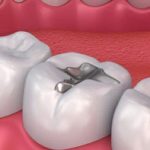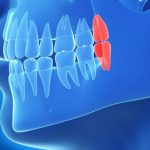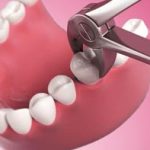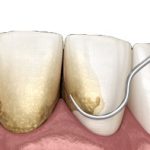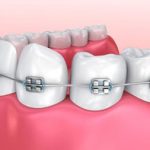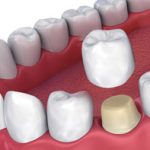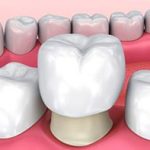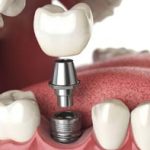DENTAL VENEERS
What are veneers?
Veneers are coverings that fit over the front surfaces of your teeth. Technicians use high-quality dental materials, like tooth-colored composite or porcelain, to create them.
Dental veneers are cosmetic in nature. They can conceal a wide range of aesthetic imperfections, including chips, cracks, gaps, tooth discoloration and more.
How do veneers work?
Veneers cover the front surfaces of your teeth to enhance your smile. They work by camouflaging cosmetic flaws.
Who needs dental veneers?
Anyone who wants to enhance the appearance of their smile can explore veneers. These dental restorations can camouflage:
- Chipped or broken teeth.
- Diastema (gaps or spaces in your smile).
- Stains that don’t improve with teeth whitening.
- Teeth that are too small.
- Misshapen teeth.
It’s important to note that veneers are only an option if you’re free of extensive cavities and gum disease. If you have serious oral health issues, you should address those first before exploring cosmetic treatments.
Veneers vs crowns: What’s the difference?
A porcelain veneer only covers the front surface of a tooth to enhance its appearance. A dental crown, on the other hand, covers the entire tooth structure to add strength and protection.
Dental veneers are a cosmetic treatment. In other words, they improve your smile, but they don’t necessarily strengthen or repair your teeth. While dental crowns can also improve the appearance of your teeth, their main purpose is to restore teeth that are badly damaged by decay or trauma.
Are there different types of veneers?
Yes. There are a few different types of veneers, including composite veneers, porcelain veneers, no-prep veneers, and removable veneers.
Composite veneers
Composite veneers can conceal mild cosmetic issues. Your dentist uses a tooth-colored composite resin — the same material used for dental bonding — to achieve the desired results.
Porcelain veneers
Porcelain veneers can address a number of aesthetic imperfections. These restorations are custom-made to fit your dental anatomy. Before placement, your dentist must remove some enamel from your natural teeth. This roughens your teeth surfaces and helps your new veneers stay in place.
No-prep veneers
No-prep or minimal-prep veneers are a less invasive option. Like traditional porcelain veneers, no-prep veneers are custom-made for your smile. However, they require less enamel removal than traditional veneers.
It’s important to understand that no-prep veneers still require some enamel removal.
No-prep veneers aren’t right for everyone. Ask your dentist if you’re a candidate.
Removable veneers
Removable veneers — also called pop-on veneers or snap-on veneers — cover your natural teeth to hide imperfections. Like retainers, you can take removable veneers out anytime. Removable veneers can enhance your smile — but they can make it difficult to eat, and they could have a negative impact on your speech.
There isn’t a lot of research available on removable veneers because they’ve only been around for a few years. Ask your dentist if this option is safe for you.
 What happens before dental veneer placement?
What happens before dental veneer placement?
During your initial appointment, your dentist will examine your teeth and gums to determine if you’re eligible for veneers. If you’re a candidate, they’ll prepare your teeth by removing small amounts of enamel. Next, they’ll take impressions of your teeth. A dental lab technician will use these impressions to make your custom veneers. (If you choose composite veneers, dental impressions aren’t needed.)
It can take a few weeks for the dental lab to complete your veneers. If necessary, your dentist can place temporary veneers in the meantime. Once the technician finishes your veneers, the lab will ship them to your dentist’s office.
What happens during veneer placement?
During a second office visit, your dentist will check the shape, color and fit of your veneers, then permanently bond them into place using dental cement. Finally, they’ll check your bite and make any necessary adjustments.
If you want to change something about your veneers, like the shape or color, let your dentist know. They’ll work with you and the dental laboratory to ensure that your results are satisfactory.
There’s no downtime following veneer placement. People who receive dental veneers can return to normal activities the same day. You can also eat or drink immediately after your appointment, as long as the anesthesia has worn off.
Do dental veneers require special care?
Brushing, flossing and visiting your dentist regularly are all you need to do to keep your veneers in good working condition. Be sure to use a soft-bristled toothbrush and non-abrasive fluoride toothpaste. Avoid whitening products, as they can scratch your veneers.
To make your veneers last, you should also avoid biting directly into hard or crunchy foods like apples, carrots and tough meats. Cut up these foods and chew them with your back teeth.
Porcelain veneers are stain resistant, but it’s still a good idea to avoid dark-colored foods and beverages, such as berries, red wine, coffee and tea. These foods and drinks can stain your veneers over time.
What are the advantages of dental veneers?
Dental veneers offer a number of benefits. For example:
- Veneers can dramatically enhance the appearance of your smile.
- They blend in with your natural teeth for lifelike results.
- Veneers resist staining better than your natural tooth enamel.
- Dental veneers don’t require any additional maintenance.
- They have a lifespan of 10 to 15 years with proper care.
What are the disadvantages of veneers?
Veneers also come with certain disadvantages. For example:
- You’ll lose at least some of your natural enamel.
- Many types of veneers aren’t reversible.
- Your teeth may become more sensitive to heat and cold.
- It’s possible for a veneer to fall off or become dislodged.
- Dental veneers are cosmetic, so they’re not covered by most insurances.
Do veneers damage your teeth?
No. Veneers don’t actively damage your teeth. However, it’s still possible for the natural tooth structure underneath to decay. Therefore, it’s important to brush, floss and visit your dentist regularly for cleanings.
Are veneers permanent?
Most types of dental veneers are permanent, meaning they aren’t reversible. Some types of veneers, such as no-prep or minimal prep, are reversible.
On average, dental veneers last between 10 to 15 years with proper care and maintenance.
Dental Veneers Procedure in Iran
To get dental veneers in Iran, the patient needs to stay 3-14 days in the country (depending on the procedure). Dental veneering is done in approximately 2 sessions. Sometimes 3 appointments are required.
Preparation session:
In this session, the dentist trims the teeth and removes about 1 mm of enamel to reach the width of the porcelain veneer and a right height and size for placing the veneer. If the patient wants to use porcelain veneers on some but not all of his/her teeth, it’s better to do a brief whitening process on other surrounding teeth.
Afterward, the dentist makes a model of the patient’s teeth (a mold) and sends the model to the dental laboratory. Each veneer is crafted separately in the laboratory. It usually takes 1 to 2 weeks for the veneers to be ready.
Fitting and bonding session
When the dental veneers are ready, the dentist temporarily places them on the patient’s teeth, in order to check their size, color and how they fit. If both the patient and dentist are satisfied with the result, the bonding phase starts.
Before permanently placing the veneers, the dentist thoroughly cleans the patient’s teeth. An acid substance is used to roughen the surface of teeth and veneers. A special cement is applied to them. Then, the veneers are fixed over the teeth.
After placing them on the teeth, a beam light is shed on the teeth, in order to activate the chemicals in the cement. This process may take about 2 to 3 hours.
In some occasions, the procedure is done under anesthesia, not because it’s painful, but because it might be hard for some patients to stay still for a long time.
In the end, the dentist removes the excess cement. The dentist also checks the alignment and how the teeth sit on each other when the mouth is closed, in other words, the “bite” is checked and corrected if necessary.
Dental Veneers Recovery
There’s no recovery period for dental veneering. You may experience discomfort or have difficulty chewing hard foods and eating hot and cold foods for about 7-14 days after the procedure. However, you can immediately go back to work and your normal life after placement of the veneers.
Dental veneers aftercare
Regular brushing and flossing, as we normally do with our teeth, is highly necessary after getting porcelain veneers. The toothpaste you use must be a non-abrasive fluoride type of toothpaste. It’s also better to limit the use of tea, coffee, red wine, and other stain-causing foods and drinks.
Dental Veneers Cost in Iran
Porcelain veneering or porcelain veneers in Iran costs around $250-$500 per tooth. Composite veneers cost less, around $100-$200 per tooth. This is while typical veneering (per tooth) costs between $800 to $1000 in the US, $500 to $700 in the UK, and $350 to $600 in Turkey. This even gains much importance when it comes to having more than one tooth laminated. So, people can save a significant amount of money by undergoing dental veneers in Iran.


